Resin-bound gravel significantly improves urban drainage systems by offering high permeability, enabling over 95% rainwater absorption. This leads to a reduction in surface runoff by more than 50%, which effectively lowers flood risks. Its porous structure not only filters out pollutants, enhancing water quality, but also meets the requirements of Sustainable Urban Drainage Systems (SuDS). Additionally, resin-bound gravel is durable enough to handle heavy traffic and requires minimal maintenance. These benefits contribute to urban resilience and help cities adapt to the impacts of climate change.
Key Takeaways
Resin-bound gravel systems improve permeability, allowing for effective rainwater absorption and reducing surface runoff by more than 50%. They facilitate groundwater recharge by enabling rainwater to seep through, which eases the burden on local drainage systems.
The porous design also filters out pollutants, enhancing water quality and minimising the environmental impact of urban runoff. Adhering to Sustainable Urban Drainage Systems (SuDS) regulations makes gaining approvals easier and supports sustainable city development.
With their durability and low maintenance needs, resin-bound gravel is perfect for busy urban areas, providing reliable drainage solutions that stand the test of time.
Understanding Permeability and Natural Drainage

Understanding permeability and natural drainage is crucial for effective urban design, particularly with resin-bound gravel systems.
By following permeability principles, you ensure water can flow easily through the resin-coated aggregate, which has small gaps for efficient drainage. This design allows rainwater to soak in quickly, reducing surface runoff and preventing puddles. Maintaining a slope of 1–2% helps direct water away from buildings, improving drainage. As rainwater seeps into the ground, it replenishes groundwater and eases pressure on municipal drainage systems. Moreover, the durability of the resin-bound system keeps it permeable over time, ensuring long-lasting effectiveness. Additionally, the combination of eco-friendly materials used in resin-bound driveways contributes to a sustainable approach to urban drainage. This system’s permeability rates can reach up to 95%, enhancing water management in urban settings.
The Role of Resin-Bound Gravel in Flood Risk Reduction

Resin-bound gravel systems are crucial for managing urban flood risk by enhancing permeability and natural drainage. These systems can reduce surface runoff by over 50%, easing the burden on storm drains.
With an impressive absorption rate of 95%, resin-bound gravel allows water to seep through quickly, preventing puddles and standing water that can lead to flooding. Additionally, they help combat urban flooding by allowing rainwater to penetrate and mitigate excess runoff. Furthermore, they provide an effective flood defense against heavy rainfall, making them particularly valuable in regions prone to elevated moisture levels.
Moreover, these surfaces help delay the peak arrival of floodwater, giving drainage systems more time to cope with excess flow and improving their overall efficiency. They also comply with Sustainable Urban Drainage Systems (SuDS), which promotes groundwater recharge while being straightforward to install.
Enhancing Water Quality Through Pollution Filtration

By using resin-bound gravel, you enhance the natural filtration of rainwater, effectively removing pollutants. This system helps reduce groundwater contamination and ensures you meet local water regulations. Consequently, you play a part in improving water quality and fostering a healthier urban environment. Additionally, the enhanced surface functionality of resin systems contributes to long-term performance in managing stormwater runoff. Furthermore, the gravel acts as a natural filter for pollutants, improving the overall quality of water that reaches the groundwater.
Natural Pollutant Filtration Process
Urban areas often struggle with stormwater pollution, but resin-bound gravel systems present a smart solution by effectively filtering out contaminants.
These systems work by utilising the natural filtration process, where the porous gaps between the gravel and resin act like a sieve to capture sediments and particles. As stormwater slows down, heavier pollutants settle, aiding in sedimentation.
Adsorption is key here; it allows dissolved contaminants, such as heavy metals, to cling to the surfaces of the gravel and resin. This engineered surface chemistry boosts pollutant absorption and improves removal rates.
Groundwater Contamination Reduction
Resin-bound gravel systems are key in reducing groundwater contamination. Their porous design effectively filters out pollutants such as suspended solids and oils, preventing them from reaching groundwater.
By promoting efficient drainage and rapid infiltration, these systems help to minimise urban runoff, allowing harmful substances to break down naturally before they enter water bodies.
Incorporating reactive materials within the gravel further enhances pollution control by capturing heavy metals and organic compounds.
This combination significantly improves filtration performance, reducing the environmental impact of urban runoff.
Compliance With Water Regulations
As urban areas face increasing scrutiny over water quality, resin-bound gravel systems offer a vital solution for meeting water regulations. These systems tackle regulatory challenges by managing both the quantity and quality of surface water runoff.
With their porous structure, resin-bound gravel allows for natural filtration, effectively removing pollutants like oils and heavy metals before they reach drainage systems. This aligns with the goals of Sustainable Drainage Systems (SuDS) and helps improve urban water quality.
When installed and maintained correctly, resin-bound gravel provides reliable performance data that demonstrates compliance with local regulations, ensuring long-term adherence.
Compliance With Sustainable Urban Drainage Systems (Suds)
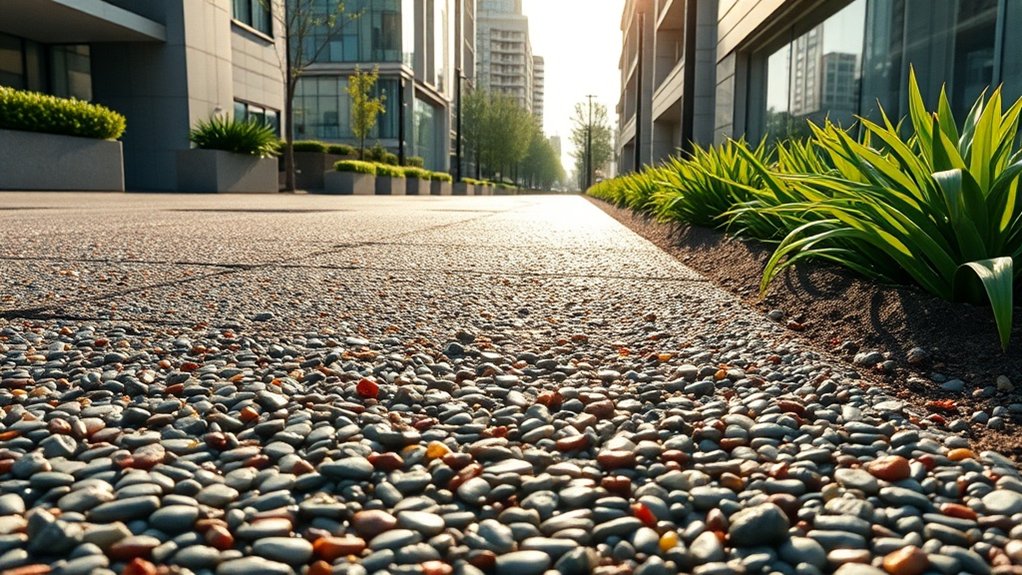
Choosing resin bound gravel for your projects not only improves drainage but also simplifies regulatory processes.
Its compliance with Sustainable Urban Drainage Systems (SUDS) can speed up approvals and lessen planning challenges, in line with environmental regulations.
This makes resin bound surfaces a smart choice for meeting both practical and legal requirements in urban development.
Regulatory Streamlining Benefits
When navigating the complexities of urban development, using resin-bound gravel can simplify regulatory processes by ensuring compliance with Sustainable Urban Drainage Systems (SuDS).
This method offers notable regulatory benefits, as permeable surfaces often don’t require planning permission and meet local drainage regulations. By improving project efficiency, developers face less administrative hassle, speeding up approvals for urban redevelopment.
Resin-bound gravel’s high absorption rates help reduce surface runoff and aid natural groundwater recharge, which aligns with flood risk reduction goals.
Additionally, its ability to filter pollutants supports water quality, meeting regulatory standards. By incorporating resin-bound gravel, you not only adhere to changing regulations but also advance sustainable design principles, boosting your project’s overall viability.
Environmental Legislation Compliance
Using resin-bound gravel not only simplifies regulatory requirements but also ensures compliance with essential environmental laws, especially concerning Sustainable Urban Drainage Systems (SuDS). This method effectively meets the challenges posed by the Flood and Water Management Act 2010 and the Sustainable Drainage (Approval and Adoption) (England) Order 2012.
| Compliance Strategies | Key Legislation |
|---|---|
| Direct runoff to appropriate areas | Flood and Water Management Act 2010 |
| Improve water quality | General Binding Rules for discharges |
| Enhance climate resilience | 2025 National Standards |
For instance, by directing rainwater to designated areas, we can reduce flooding risk and protect our waterways. This approach not only benefits the environment but also supports local communities in adapting to changing weather patterns.
Safety Features and Slip Resistance of Resin-Bound Surfaces

Safety is crucial in urban design, and resin-bound surfaces stand out for their excellent slip resistance.
All RonaDeck blends comply with safety standards set by BS 8204-6:2008+A1:2010, achieving a low slip potential both in dry (SRV of 50) and wet conditions (SRV of 42).
The textured finish from natural aggregates increases grip, while the permeable nature of the surface helps prevent standing water, reducing slip risks.
In high-risk areas, we can add anti-slip additives or aggregates to enhance traction without sacrificing appearance.
Regular maintenance, like sweeping and power washing, is vital to avoid moss and algae build-up, ensuring slip resistance remains effective over time.
These features make resin-bound surfaces a dependable option for urban spaces.
Durability and Low Maintenance Benefits

Resin-bound gravel surfaces offer excellent slip resistance along with impressive durability and low maintenance.
Designed to withstand heavy foot and vehicle traffic, these surfaces remain crack-free even in harsh weather. Their permeability ensures effective water drainage, reducing the risk of freeze-thaw damage and extending their lifespan.
Installation creates a strong bond between the resin and aggregates, enhancing the look while protecting against pollutants.
Maintenance is straightforward, requiring only the occasional sweep and a pressure wash to keep things tidy. The smooth finish also discourages weed growth and prevents algae, making it a practical choice for urban areas.
Environmental Advantages of Resin-Bound Gravel
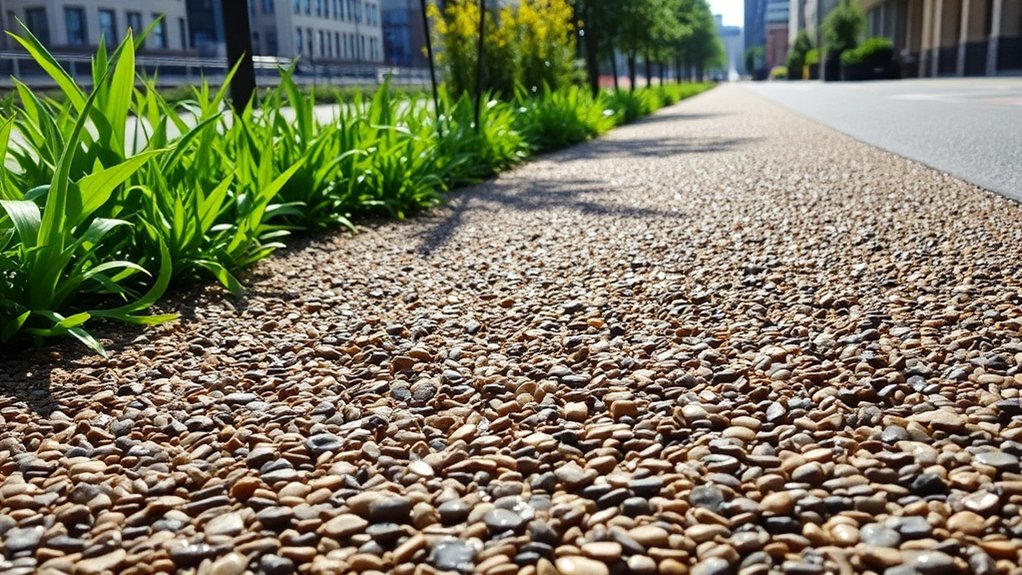
Resin-bound gravel provides notable environmental benefits, particularly in improving natural water filtration and encouraging groundwater recharge.
Its permeable surface allows rainwater to soak through, which helps to minimise surface runoff and supports effective water management.
Furthermore, using locally sourced and recycled materials enhances its sustainability, making it an excellent option for urban drainage solutions.
Natural Water Filtration
When rainwater falls, it often causes runoff that can lead to flooding and water pollution. Resin-bound gravel is crucial for natural filtration, allowing water to pass through its porous structure. This filtration process captures contaminants such as oil, grease, and heavy metals, preventing them from contaminating groundwater and surface water.
By filtering out these pollutants, resin-bound gravel enhances water quality, supporting healthier urban environments.
Following Sustainable Urban Drainage Systems (SUDS) guidelines ensures eco-friendly practices. This material not only reduces stormwater runoff but also promotes urban biodiversity, making our cities more resilient.
Ultimately, the natural filtration abilities of resin-bound gravel help create sustainable urban landscapes and contribute to a cleaner ecosystem.
Groundwater Recharge Enhancement
Urban areas struggle with groundwater recharge due to the prevalence of impermeable surfaces. Resin-bound gravel surfaces, however, are highly permeable, allowing up to 95% of rainwater to seep directly into the ground. This process supports the sustainability of groundwater by replenishing urban aquifers, particularly in areas reliant on aquifers where over-extraction poses a risk.
By avoiding traditional drainage systems, resin-bound gravel minimises surface runoff, preventing water pooling and ensuring ongoing recharge during heavy rainfall. These surfaces can handle drainage rates of up to 850 litres per minute per square metre, effectively replicating natural water flow patterns.
If adopted widely, this approach can harmonise urban water demand with natural supply, fostering long-term water security and healthier ecosystems.
Sustainable Material Utilization
Using locally sourced and recycled aggregates in resin-bound gravel systems boosts sustainability and significantly cuts environmental impact.
By choosing local materials, you reduce transportation emissions and carbon footprints, enhancing resource efficiency. Incorporating recycled materials supports the circular economy, lessening the need for new resources and keeping construction waste out of landfills.
This approach helps urban materials to become more eco-friendly, effectively reducing waste. Moreover, the durability of resin-bound gravel surfaces means fewer replacements and less maintenance, further benefiting the environment.
Applications in Urban Settings
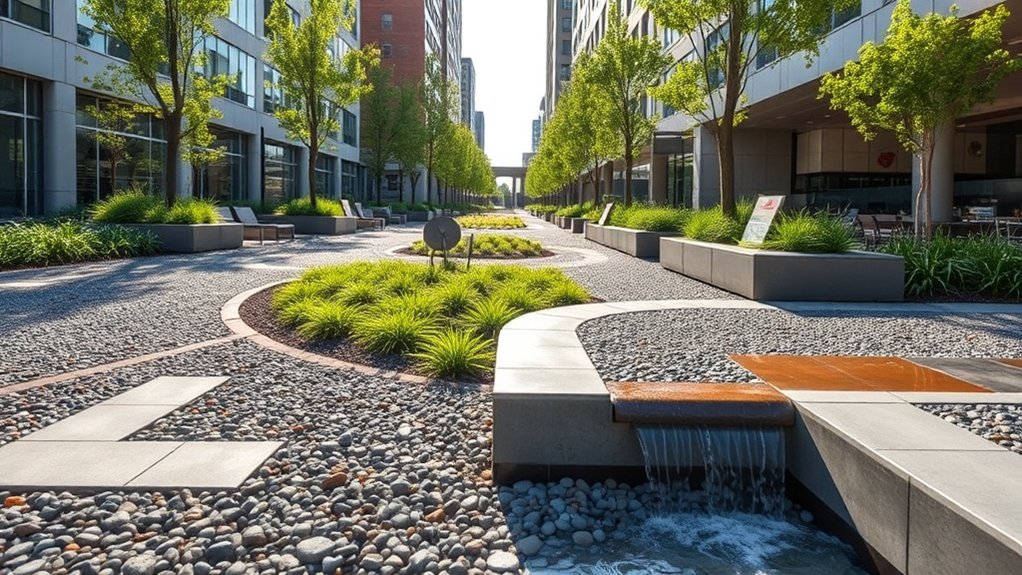
Resin-bound gravel is an excellent option for various urban applications due to its versatility.
It can be effectively used across different settings, merging functionality with aesthetic appeal in urban landscapes.
- Suitable for entertainment parks, sports stadiums, and car parks at shopping centres
- Ideal for cycle lanes, bus lanes, and commercial paving
- Perfect for heritage areas, enhancing natural stone aesthetics
- Supports multiple uses with pool surrounds, pathways, and patios
Mitigating Climate Change Effects With Permeable Solutions
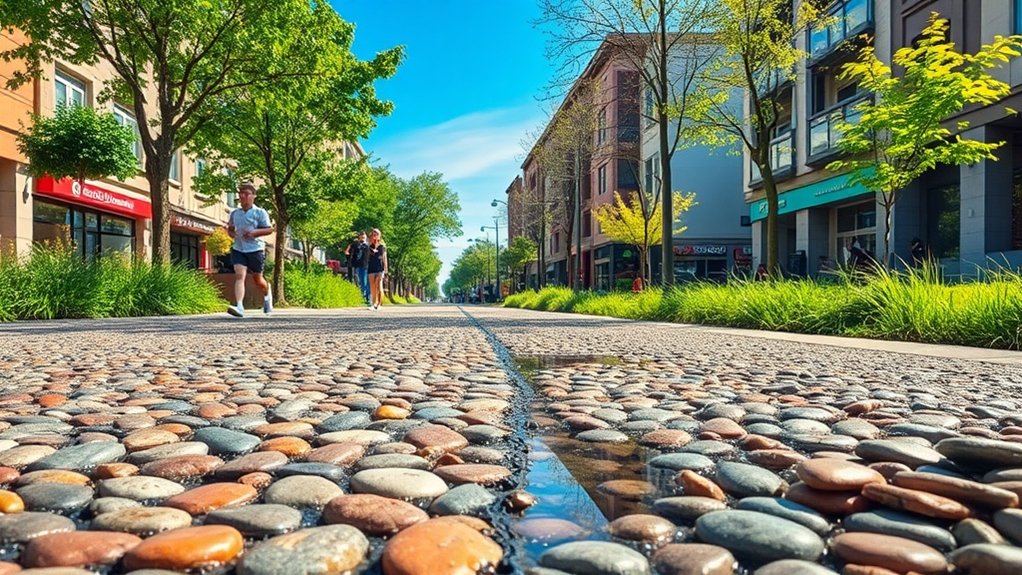
As climate change leads to more intense storms, managing increased stormwater runoff is crucial for urban resilience.
Using permeable solutions, such as resin-bound gravel, allows water to soak in, reducing surface runoff and peak flow. This approach mimics natural water cycles, managing stormwater at its source and helping to offset rising flood levels.
Research shows that permeable infrastructure can reduce flood volumes by up to 100% in simulated climate scenarios. Furthermore, these solutions ease the pressure on existing drainage systems, which can lower long-term adaptation costs.
Case Studies of Successful Implementations
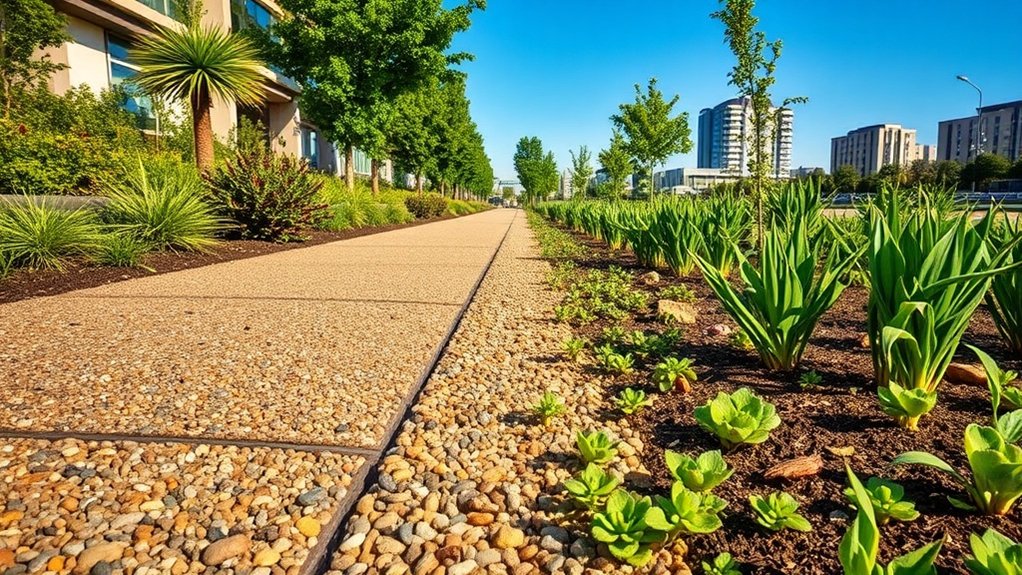
Successful implementations of resin-bound gravel in urban areas highlight its effectiveness in managing stormwater runoff while improving the local environment.
- In Central Park, the walkways have enhanced drainage and accessibility, seamlessly integrating with the surrounding greenery and boosting the park’s aesthetics.
- The redesign of Pioneer Square effectively managed heavy rainfall, reducing flooding and encouraging community engagement, which in turn has benefited local businesses.
- A residential driveway in Devon solved flooding issues without the need for complex systems, all while enhancing curb appeal with a custom finish.
- A commercial site in Essex demonstrated compliance with SuDS regulations, utilising UV-resistant resin for durability and low maintenance, showcasing the key advantages of this material.
These examples illustrate that resin-bound gravel is a sustainable solution that improves urban infrastructure while maintaining visual appeal.
Future Trends in Urban Drainage Solutions
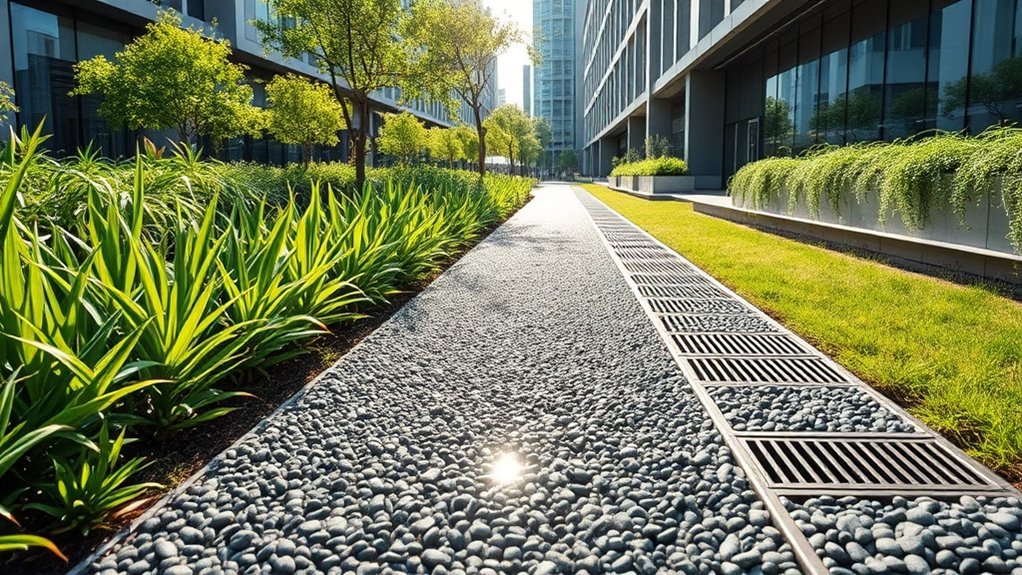
Urban drainage solutions are evolving swiftly to tackle the challenges of climate change and urban growth. Innovations like IoT integration allow for real-time monitoring and proactive maintenance, which can help minimise emergency repairs.
For instance, advanced materials such as resin-bound gravel improve water infiltration, while self-cleaning surfaces enhance water quality.
Future strategies are prioritising sustainability and climate resilience, adapting drainage systems to cope with unpredictable rainfall and extreme weather events. Policies are increasingly supporting sustainable urban drainage systems (SuDS), encouraging green infrastructure and collaboration across different sectors.
Digitalisation and automation are streamlining operations, enabling efficient flow management based on predictive analytics.
As our urban landscapes change, these trends will ensure that drainage systems remain effective, resilient, and environmentally friendly.
Frequently Asked Questions
Can Resin-Bound Gravel Be Installed Over Existing Surfaces?
Yes, resin-bound gravel can be laid over existing surfaces, but proper preparation is essential. Ensure the base is stable, clean, and dry to ensure good adhesion and durability. For instance, if you’re considering laying it over an old concrete driveway, check for cracks and clean off any debris. This will help achieve the best results.
How Does Resin-Bound Gravel Compare to Permeable Concrete?
Resin-bound gravel boasts an impressive 95% permeability, making it a far superior option for drainage compared to permeable concrete, which can fall short in effectiveness. Both materials help manage water, but resin-bound gravel is particularly effective at reducing flooding and requires minimal maintenance over time. For example, in heavy rain, resin-bound gravel will allow water to drain quickly, preventing puddles and potential water damage. Overall, it’s a reliable choice for those looking to enhance drainage in their outdoor spaces.
Is Resin-Bound Gravel Suitable for All Climates?
Yes, resin-bound gravel is suitable for a range of climates. It can handle temperatures from -20°C to 60°C, making it durable in both cold and warm conditions, provided it’s installed correctly. For example, in colder areas, proper installation can help prevent cracking, while in warmer regions, it can resist softening.
What Colors and Finishes Are Available for Resin-Bound Gravel?
Resin-bound gravel comes in a range of colours, from warm shades like amber to cool greys. You can choose from smooth or textured finishes, allowing for customised designs that fit various urban styles.
How Long Does Installation of Resin-Bound Gravel Typically Take?
The installation of resin-bound gravel usually takes between one to three days, depending on how complex the project is. For instance, a simple driveway may be completed quicker than a larger patio area. By preparing well and applying the resin efficiently, you can streamline the process and minimise any delays.
Conclusion
Incorporating resin-bound gravel into urban drainage systems enhances permeability, reduces flood risk, and improves water quality, all while adhering to sustainable practices. It provides safety through slip resistance and can be used in various urban settings, from driveways to public pathways. By addressing the impacts of climate change, it contributes to building resilient infrastructure. As cities grow, adopting these innovative solutions ensures effective drainage, supports sustainable development, and promotes a healthier environment, striking a balance between urbanisation and nature.
